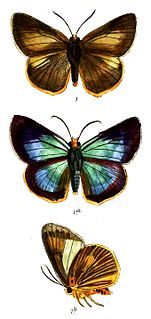
Danainae is a subfamily of the family Nymphalidae, the brush-footed butterflies. It includes the Daniadae, or milkweed butterflies, who lay their eggs on various milkweeds on which their larvae (caterpillars) feed, as well as the clearwing butterflies (Ithomiini), and the tellervini.

Burara jaina, the orange awlet, is a species of hesperid butterfly found in Asia. The butterfly was reassigned to the genus Burara by Vane-Wright and de Jong (2003), and is considered Burara jaina by them.

Bibasis harisa, the orange awlet, is a species of hesperid found in Asia. The butterfly was reassigned to genus Burara by Vane-Wright and de Jong (2003) and is considered by them to be Burara harisa.
Bibasis vasutana, the green awlet, is a species of hesperid butterfly found in Asia. The butterfly was reassigned to genus Burara by Vane-Wright and de Jong (2003) and is considered by them to be Burara vasutana.

Burara amara, the small green awlet, is a species of hesperid butterfly found in Northeast India and Southeast Asia. The butterfly has been reassigned to the genus Burara by Vane-Wright and de Jong (2003) and is now Burara amara.

Bibasis oedipodea, the branded orange awlet, is a species of hesperid butterfly found in South Asia and Southeast Asia. The butterfly was reassigned to the genus Burara by Vane-Wright and de Jong (2003) and is considered by them to be Burara oedipodea.
Protoploea apatela, the magpie, is a species of nymphalid butterfly in the Danainae subfamily.
Robert Herbert Carcasson was an English entomologist who specialised in butterflies, but also authored two field guides to tropical fishes. He joined the Coryndon Museum, Nairobi, as senior entomologist in 1956. He then became its director, under the museum's new name of the Natural History Museum from 1961 to 1968. During this time he was awarded a PhD for his studies on African hawkmoths. From 1969 to 1971 he was Chief Curator of the Centennial Museum, Vancouver, Canada. In 1972 he travelled in Polynesia, Melanesia, Australia, Malaysia, Sri Lanka, Seychelles and East Africa for production of two field guides to coral reef fish of the Indo-Pacific region. From 1973 to 1979 he was Curator of Entomology at the Museum of British Columbia. He died of cancer. Somewhat a polymath, he was fluent in a number of languages, and produced the illustrations to a number of his works, culminating in hundreds of colour and line drawings of fishes for his reef fish field guides.

Phylogenetic diversity is a measure of biodiversity which incorporates phylogenetic difference between species. It is defined and calculated as "the sum of the lengths of all those branches that are members of the corresponding minimum spanning path", in which 'branch' is a segment of a cladogram, and the minimum spanning path is the minimum distance between the two nodes.

Surendra is a genus of butterflies in the family Lycaenidae. It belongs to the subfamily Theclinae often called hairstreaks. It is often grouped into the tribe Arhopalini along with its sister genera Arhopala, Flos and Semanga. The genus is sometimes known by the common name acacia blues in reflection of the host plant of the larvae.

Pseudoborbo is an Indomalayan genus of skippers in the family Hesperiidae.The genus is monotypic containing the single species Pseudoborbo bevani found in South India ,Assam, Burma, Peninsular Thailand, Sumatra and Yunnan The larva feeds on Imperata, Oryza, Paspalum, Saccharum.

Mynes is a butterfly genus in the family Nymphalidae found in Australia and Indonesia.

Pharmacophagus antenor, the Madagascar giant swallowtail, is a butterfly from the family Papilionidae. As the common name implies, it is large and endemic to Madagascar. It is the only species in the genus Pharmacophagus.

Tipulinae is a subfamily of crane flies. It contains the typical crane flies from the genus Tipula.
Papilio arnoldiana is a species of swallowtail butterfly from the genus Papilio that is found in south-western Ethiopia.
Papilio microps is a species of swallowtail butterfly from the genus Papilio that is found in Ethiopia and Somalia.
Graphium ucalegonides is a butterfly in the family Papilionidae (swallowtails). It is found in Cameroon, the Republic of the Congo, northern Angola, the Democratic Republic of the Congo and Chad.
Byasa daemonius is a butterfly described by Sergei Alphéraky in 1895. It is found in Tibet and western China, that belongs to the windmills genus Byasa, comprising tailed black swallowtail butterflies with white spots and red submarginal crescents.
Pachliopta adamas is a swallowtail butterfly belonging to the genus Pachliopta, the roses, or red-bodied swallowtails. It is found in Bawan, Java, and Enggano.

Druryia is a subgenus within the genus Papilio containing 36 species:











